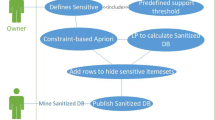Abstract
Developments in leaps and bounds in communication and database technology have made resource sharing easy and simple. Data mining is widely used as a business intelligence tool in order to derive meaningful information from centralized or distributed data sources. Recent advances in data mining algorithms have increased the security risks by revealing the sensitive information contained in a data source. When multiple parties are allowed to mine a centralized data source, sensitive information of one party may become easily accessible by another party which is not secured. This proposed work deals with ways and means to hide sensitive information of various parties thus enabling access to legitimate information while securing the sensitive information of other parties. A new data structure called Reduced Transaction Table (RTT) has been proposed to locate transactions pertaining to the sensitive information without multiple scans of the data source thereby reducing the time complexity. The performance of the proposed method is empirically verified and found that it achieves better performance than the existing one.





Similar content being viewed by others
Explore related subjects
Discover the latest articles, news and stories from top researchers in related subjects.References
Agrawal D, Aggarwal C (2001) On the design and quantification of privacy preserving data mining algorithms. In: The Proceedings of 20th ACMSIGACT-SIGMOD-SIGART Symposium on Principles of database systems, CA, USA, pp 247–255
Agrawal R, Imielinski T, Swami AN (1993) Mining association rules between sets of items in large databases. In: The Proceeding ACM SIGMOD International Conference on Management of Data, Washington, D.C., pp 207–216
Agrawal R, Srikant R (1994) Fast algorithms for mining association rules. In: Proceedings of the 20th VLDB Conference Santiago, Chile, pp 487–499
Agarwal R, Srikant R (2000) Privacy preserving data mining. In: Proceedings of ACM SIGMOD Conference on Management of Data (Texas, USA), pp 439–450
Angiulli F, Ianni G, Palopoli L (2001) On the complexity of mining association rules. In: Proceedings of Nono Convegno Nazionale su Sistemi Evoluti di asidi Dati (SEBD), pp. 177–184
Atallah M, Bertino E, Elmagarmid A, Ibrahim M, Verykios VS (1999) Disclosure limitation of sensitive rules. In: Proceedings of the IEEE Knowledge and Data Exchange Workshop (KDEX’99). IEEE Computer Society, pp 45–52
Bertino E, Fovino I, Provenza L (2005) A framework for evaluating privacy preserving data mining algorithms. Data Mining Knowl Discov 11(2):121–154
Berson A, Smith SJ (2004) Data warehouse, data mining and OLAP. Tata McGraw Hill Press, New Delhi
Biggio B, Fumera G, Roli F (2010) Multiple classifier systems for robust classifier design in adversarial environments. Int J Mach Learn Cybern 1(4):27–41
Clifton C, Marks D (1996) Security and privacy implications of data mining. In: Proceedings of the ACM SIGMOD Workshop on data mining and knowledge discovery, pp 15–19
Cormen TH, Leiserson CE, Rivest RL (1990) Introduction to algorithms. MIT Press, Cambridge
Fayyad U, Shapiro G, Smyth P, Uthrusamy R (1996) Advances in knowledge discovery and data mining, AAAI Press/MIT Press, Menlo Park
Gkoulalas-Divanis A, Verykios S (2009) Exact knowledge hiding through database extension. IEEE Trans Knowl Data Eng 21(5):699–713
Han J, Fu Y (1995) Discovery of multiple-level association rules from large databases. In: Proceedings of 1995 International Conference on Very Large Data Bases (VLDB'95), Zürich, Switzerland, pp 420–431
Han J, Kamber M (2001) Data mining: concepts and techniques, Morgan Kaufmann Publishers, San Francisco
Han J, Pei J, Yin Y, Mao R (2004) Mining frequent patterns without candidate generation: a frequent-pattern tree approach. IEEE Trans Data Mining Knowl Discov 8(1):53–87
Lee G, Chang C, Chen ALP (2004) Hiding sensitive patterns in association rules mining. In: Proceedings of the 28th Annual International Computer Software and Applications Conference (COMPSAC’04)
Lin D, Kedem ZM (2002) Pincer-search: an efficient algorithm for discovering the maximum frequent set. IEEE Trans Knowl Data Eng 14(3):553–556
Lindell Y, Pinkas B (2000) Privacy preserving data mining. Lecture Notes in Computer Science
Nedunchezhian R, Anbumani K (2006) Rapid privacy preserving algorithm for large databases international. J Intell Inform Technol 2(1):68–81
Oliveira S, Zaiane O (2003) Privacy preserving clustering by data transformation. In: Proceedings of the 18th Brazilian Symposium on Databases (SBBD 2003), pp 304–318
Saygin Y, Verykios S, Elmagarmid K (2002) Privacy preserving association rule mining. In: Proceedings of 12th International Workshop on Research Issues in data engineering: engineering e-commerce/e-business systems (RIDE’02), San Jose, pp 151–158
Srikant R, Agrawal R (1996) Mining quantitative association rules in large relational tables. In: Proceedings of ACM SIGMOD International Conference on Management of Data, Montreal, Canada, pp 1–12
Stanley R, Oliveira M, Zaiane O (2003) Protecting sensitive knowledge by data sanitization. In: Proceedings of Third IEEE International Conference on data mining (ICDM’03), Florida, pp 613–616
Stanley R, Oliveira M, Zaiane R (2002) Privacy preserving frequent itemset mining. In: Proceedings of the IEEE international conference on privacy, security and data mining (PSDM’02), Maebashi, pp 43–54
Vaidya J, Clifton C (2004) Privacy-preserving data mining: why, how, and when. IEEE Security Priv 2(6):19–27
Verykios S, Elmagarmid K, Bertino E, Saygin Y, Dasseni E (2004) Association rule hiding. IEEE Trans Knowl Data Eng 16(4):434–447
Verykios S, Bertino E, Provenza I, Saygin Y, Theodoridis Y (2004) State-of-the-Art in privacy preserving data mining. ACM SIGMOD Record 33(1):50–57
Wu Y, Chiang C, Chen A (2007) Hiding sensitive association rules with limited side effects. IEEE Trans Knowl Data Eng 19(1):29–42
Zaki MJ (2000) Generating non-redundant association rules. In: The proceedings of The Sixth ACM SIGKDD International Conference on knowledge discovery and data mining, pp 34–43
Author information
Authors and Affiliations
Corresponding author
Rights and permissions
About this article
Cite this article
Rajalakshmi, M., Purusothaman, T. Concealing party-centric sensitive rules in a centralized data source. Int. J. Mach. Learn. & Cyber. 4, 515–525 (2013). https://doi.org/10.1007/s13042-012-0111-y
Received:
Accepted:
Published:
Issue Date:
DOI: https://doi.org/10.1007/s13042-012-0111-y




